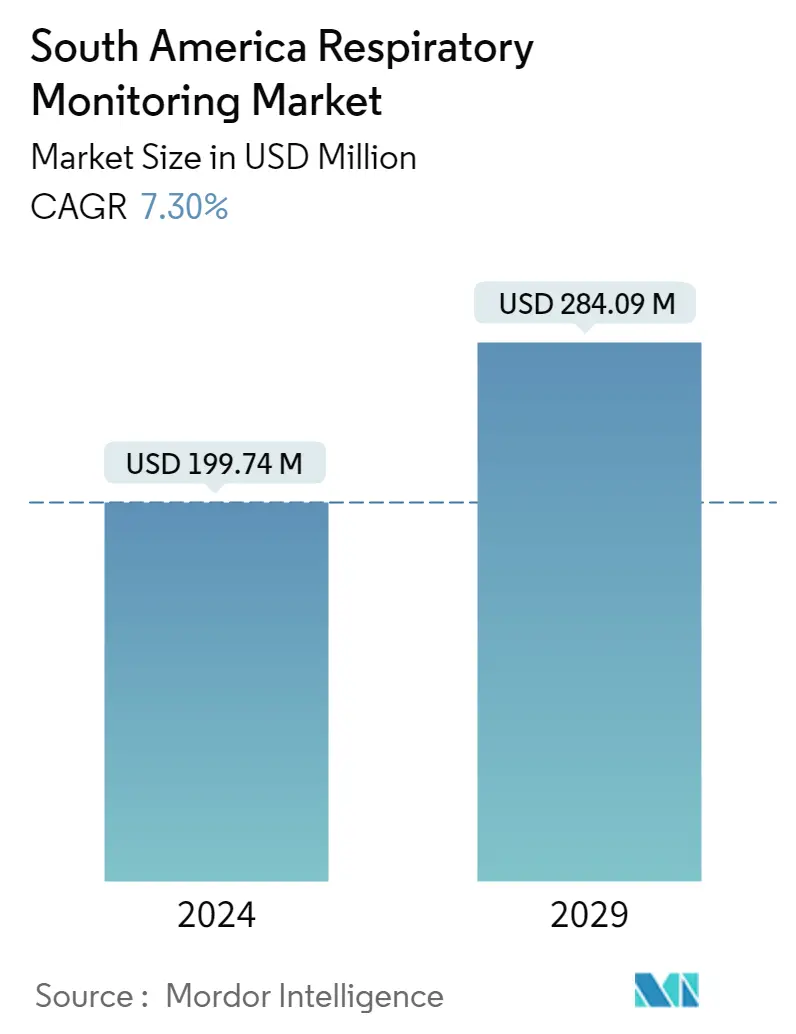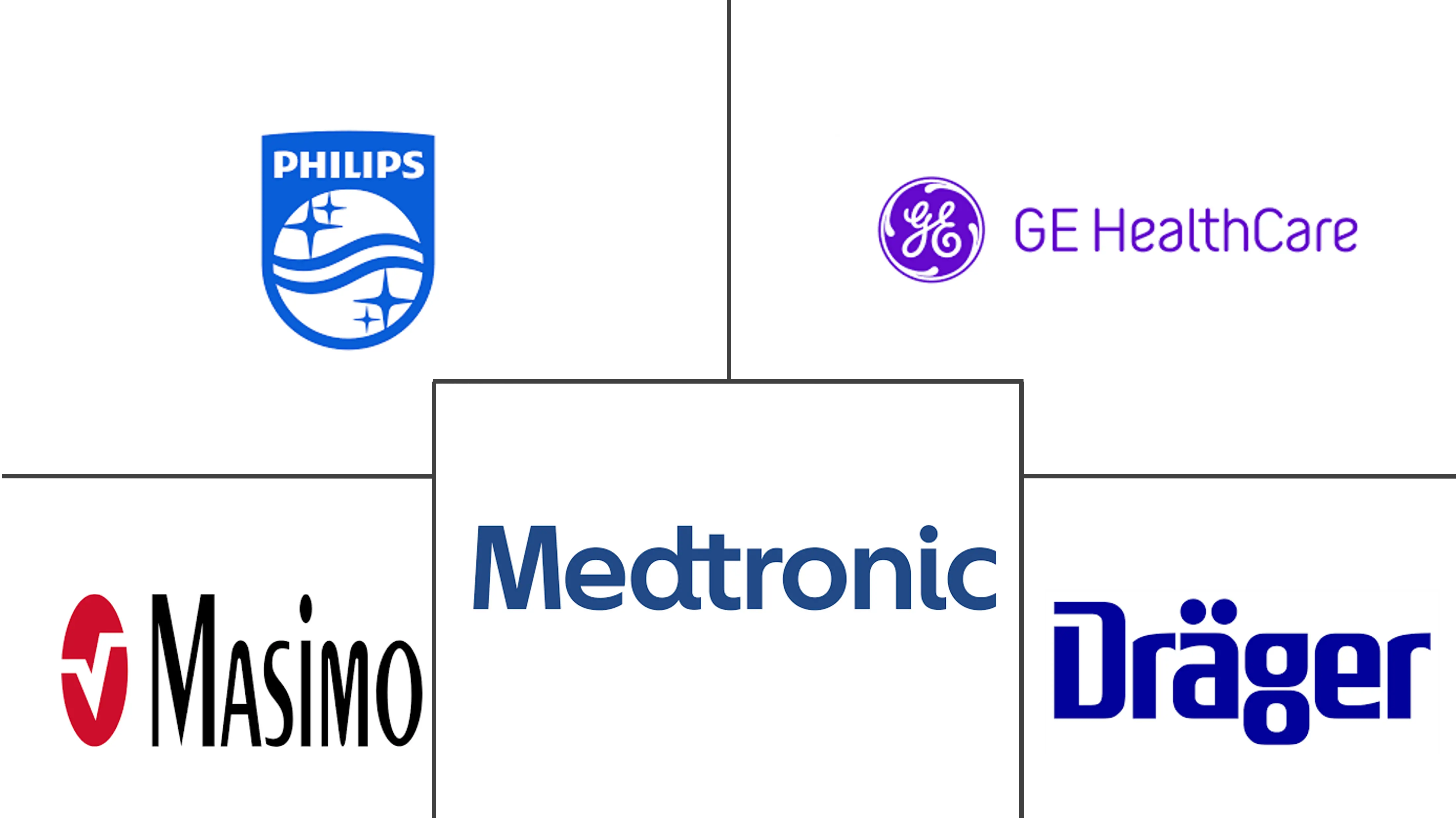Market Size of South America Respiratory Monitoring Industry

| Study Period | 2019 - 2029 |
| Base Year For Estimation | 2023 |
| Forecast Data Period | 2024 - 2029 |
| Market Size (2024) | USD 199.74 Million |
| Market Size (2029) | USD 284.09 Million |
| CAGR (2024 - 2029) | 7.30 % |
Major Players
*Disclaimer: Major Players sorted in no particular order |
South America Respiratory Monitoring Market Analysis
The South America Respiratory Monitoring Market size is estimated at USD 199.74 million in 2024, and is expected to reach USD 284.09 million by 2029, growing at a CAGR of 7.30% during the forecast period (2024-2029).
- The COVID-19 pandemic impacted the respiratory monitoring market significantly. The demand for respiratory monitoring devices has witnessed significant growth during the pandemic due to the increasing number of COVID-19 cases that require continuous respiratory monitoring. As per the study published in MDPI Journal in June 2021, lower CO2 levels were associated with an increased risk of death in COVID-19 patients. Hence, analysis of the capnogram became useful for tracking CO2 levels in COVID-19 patients. Thus, increasing demand for capnograms for monitoring CO2 levels in COVID-19 patients drove the market over the pandemic. According to an article published in the American Journal of Public Health in August 2022, South America turned out to be one of the most vulnerable areas to the pandemic because of regional disparities in health capacities, weak health authority, and structural and historical inequalities that undergird social determinants of health.
- The major factors driving the market's growth include:
- The rise in the prevalence of respiratory diseases.
- A high prevalence of tobacco smoking.
- The development of advanced technologies in respiratory monitoring devices.
- COPD is prevalent in South America owing to multiple factors, such as increased cigarette smoking, exposure to tobacco smoke, and high air pollution. According to a systematic review and meta-analysis published by National Center for Biotechnology Information in 2021, the prevalence of COPD from 37 studies was 7.6%, and pooled prevalence from 26 spirometry estimates was 8.9%. The high prevalence of respiratory disease and tobacco smoking are expected to increase the demand for respiratory monitoring, eventually driving the market over the forecast period.
- Therefore, the increasing prevalence of respiratory diseases has augmented the demand for early diagnosis. All these factors are expected to drive the South American respiratory monitoring market over the forecast period. However, reimbursement concerns and the high cost of monitoring devices are expected to restrain the market's growth.
South America Respiratory Monitoring Industry Segmentation
As per the report's scope, respiratory monitoring devices help monitor various respiratory disorders. These devices diagnose acute or chronic respiratory diseases by determining the respiratory capabilities of the lungs. Several respiratory tests are designed to observe the efficiency of the lungs in exchanging respiratory gases and identify obstructions in the respiratory tract. The South American respiratory monitoring market is segmented by type of device (spirometers, peak flow meters, sleep test devices, gas analyzers, pulse oximeters, capnographs, and other types of devices) and geography (Brazil, Argentina, and the Rest of South America).
The report offers the value (in USD million) for the above segments.
| By Type of Device | |
| Spirometers | |
| Peak Flow Meters | |
| Sleep Test Devices | |
| Gas Analyzers | |
| Pulse Oximeters | |
| Capnographs | |
| Other Types of Devices |
| By Geography | |
| Brazil | |
| Argentina | |
| Rest of South America |
South America Respiratory Monitoring Market Size Summary
The South American respiratory monitoring market is poised for significant growth, driven by the increasing prevalence of respiratory diseases and the high rates of tobacco smoking in the region. The COVID-19 pandemic has further accelerated the demand for respiratory monitoring devices, as the need for continuous monitoring of patients became critical. The market is characterized by the rising adoption of advanced technologies in respiratory monitoring devices, which are essential for early diagnosis and management of chronic conditions such as COPD and tuberculosis. Despite the challenges posed by high device costs and reimbursement issues, the market is expected to expand, supported by the growing geriatric population and the need for portable monitoring solutions.
Brazil is anticipated to lead the market due to its high incidence of respiratory diseases and acute respiratory infections. The country's significant tobacco usage and the prevalence of conditions like asthma and COPD are key factors driving the demand for respiratory monitoring devices. The market landscape is slightly consolidated, with major global companies like Medtronic, Dragerwerk AG, and Koninklijke Philips NV holding substantial market shares. Initiatives such as donations of pulse oximeters and the development of portable monitoring systems highlight the ongoing efforts to enhance respiratory health monitoring in the region. As the market continues to evolve, the focus on improving healthcare infrastructure and addressing regional disparities will be crucial for sustained growth.
South America Respiratory Monitoring Market Size - Table of Contents
-
1. MARKET DYNAMICS
-
1.1 Market Overview
-
1.2 Market Drivers
-
1.2.1 Rise in the Number of Chronic Obstructive Pulmonary Disease Patients (COPD), Asthma, TB, etc.
-
1.2.2 High Prevalence of Tobacco Smoking
-
-
1.3 Market Restraints
-
1.3.1 Reimbursement Concerns
-
1.3.2 High Price of the Monitoring Devices
-
-
1.4 Industry Attractiveness - Porter's Five Force Analysis
-
1.4.1 Threat of New Entrants
-
1.4.2 Bargaining Power of Buyers/Consumers
-
1.4.3 Bargaining Power of Suppliers
-
1.4.4 Threat of Substitute Products
-
1.4.5 Intensity of Competitive Rivalry
-
-
-
2. MARKET SEGMENTATION (Market Size by Value - USD million)
-
2.1 By Type of Device
-
2.1.1 Spirometers
-
2.1.2 Peak Flow Meters
-
2.1.3 Sleep Test Devices
-
2.1.4 Gas Analyzers
-
2.1.5 Pulse Oximeters
-
2.1.6 Capnographs
-
2.1.7 Other Types of Devices
-
-
2.2 By Geography
-
2.2.1 Brazil
-
2.2.2 Argentina
-
2.2.3 Rest of South America
-
-
South America Respiratory Monitoring Market Size FAQs
How big is the South America Respiratory Monitoring Market?
The South America Respiratory Monitoring Market size is expected to reach USD 199.74 million in 2024 and grow at a CAGR of 7.30% to reach USD 284.09 million by 2029.
What is the current South America Respiratory Monitoring Market size?
In 2024, the South America Respiratory Monitoring Market size is expected to reach USD 199.74 million.

